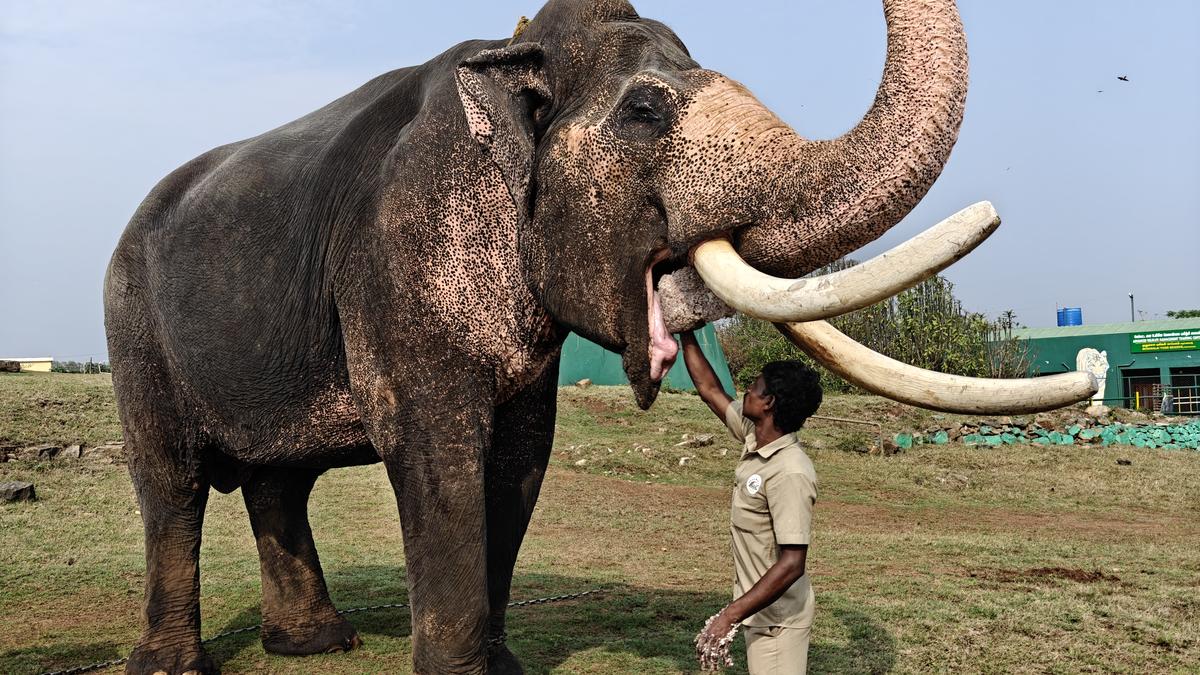
What’s the special diet for elephants at the Theppakadu Elephant Camp
The Hindu
The meal time ritual for elephants at the Theppakadu Elephant Camp is also an opportunity to watch the majestic beings in their natural habitat and learn to care for them
As dusk sets over The Nilgiris, the river Moyar is bathed in a golden hue. Peacocks make loud, plaintive calls as they show off their beautiful plumage while grey langurs forage for berries. A stocky wild boar makes its presence felt briefly and the air is streaked with the loud calls of racket-tailed drongos and jungle mynahs. Tucked away amidst the Mudumalai Tiger Reserve (MTR), along the banks of the river, is the Theppakadu Elephant Camp, one of the oldest camps in Asia that dates back to the 1920s where as many as 27 elephants are rehabilitated.
Visitors can observe elephants in their natural habitat, observe their behaviour, and activities like feeding and bathing under the supervision of trained mahouts.
“During the British times, elephants were captured from the forest, trained, and used for hauling timber logs,” says C Vidhya, Deputy Director of MTR (Core Area) adding that a paradigm shift in forest conservation turned such camps to rehabilitation centres for elephants captured from the forest due to conflicts, issues, or injuries.
Inside the camp, a bunch of mahouts and kavadis, who are caretakers of elephants, are mixing giant food blocks made of cooked horse-gram, white rice, and ragi, throwing in a dash of mineral mix and salt, all under the watchful eyes of Dr K Rajesh Kumar, the camp veterinarian. “An adult elephant in the wild grazes for 16 to 18 hours a day and consumes about 200 kilograms of greens. As camp elephants have bathing rituals, training etc, there is loss of grazing time. This supplement diet, fed every morning and evening, makes up for it,” he says, adding that the feeding time also enriches the bonding between mahouts and elephants. He arrives at the diet chart based on age, weight, and physiology status, which is reviewed every three months.
It is the only camp where elephants are trained without using conventional tools like ankush ( a stick with a pointed hook). The tribal communities of Kaatunaickers, Kurumbas, and Malasars have been the caretakers for generations. C Mari, a mahout for three decades talks fondly of 65-year-old Kamatchi, captured from Pollachi. He has taken care of six elephants like Senthivadivdu, Cheran, and Bama over the years. “Like children, they will take feed only when hungry. They are also naughty and like to play in the mud. We use commands like baitu, uttu, oopar dekh, enicho, a smattering of Hindi and Malayalam, while training them. Nutritious food is the key to maintain the overall health of elephants, especially in the initial years till they reach 10 or 15.”
The camp’s feeding ritual is unique. A jumbo kitchen runs like clockwork through the day with giant cooking vessels churning food for the gentle giants.
“Horsegram, ragi and rice are cooked for hours and mashed before placing them in square moulds. The micronutrients are always a part of their diet, unless there is a special diet prescribed by the veterinarian, like including fruits or chickpeas,” explains the Deputy Director.





















 Run 3 Space | Play Space Running Game
Run 3 Space | Play Space Running Game Traffic Jam 3D | Online Racing Game
Traffic Jam 3D | Online Racing Game Duck Hunt | Play Old Classic Game
Duck Hunt | Play Old Classic Game











